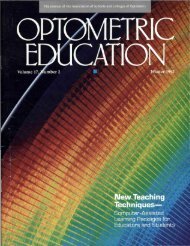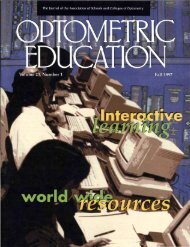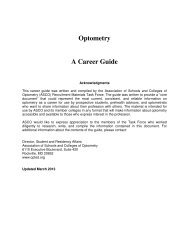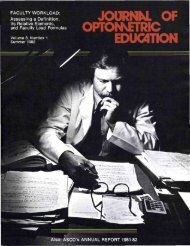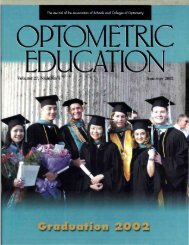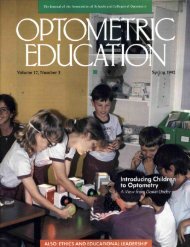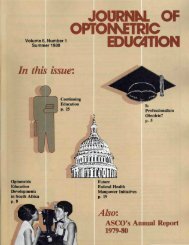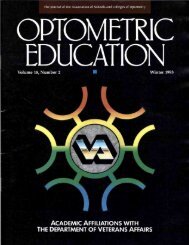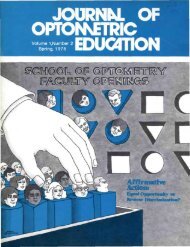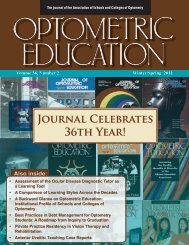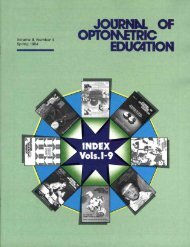Entry-Level Competencies and Learning Objectives In Visual ...
Entry-Level Competencies and Learning Objectives In Visual ...
Entry-Level Competencies and Learning Objectives In Visual ...
You also want an ePaper? Increase the reach of your titles
YUMPU automatically turns print PDFs into web optimized ePapers that Google loves.
<strong>Entry</strong>-<strong>Level</strong> <strong>Competencies</strong> <strong>and</strong> <strong>Learning</strong> <strong>Objectives</strong><br />
<strong>In</strong> <strong>Visual</strong> Impairment <strong>and</strong> Low Vision Rehabilitation<br />
INTRODUCTION<br />
Assessment <strong>and</strong> management of patients with impaired vision has been part of the curricula at<br />
schools <strong>and</strong> colleges of optometry throughout North America for many decades. These low<br />
vision curricula have evolved differently at the various schools <strong>and</strong> colleges, with varying depth<br />
<strong>and</strong> breadth of classroom, laboratory, <strong>and</strong> clinical activities, but with all students held<br />
responsible for core low vision knowledge for National Board examinations. Nevertheless,<br />
concerns have arisen about the adequacy of current low vision education in meeting public<br />
health needs, primarily based on the observation that only a minority of practicing optometrists<br />
provide any low vision care 1 . Only 36% of optometrists responding to the 2006 AOA Scope of<br />
Practice Survey indicated that they provided some level of low vision services. However, nine<br />
out of ten (89.9%) ODs reported that they managed or co-managed patients with macular<br />
degeneration. 2<br />
More than four out of five (84.6%) reported referring low vision patients<br />
elsewhere for services, while only 25.4% indicated that they accepted low vision referrals from<br />
other practitioners.<br />
There are a range of possible explanations for the modest clinical involvement of optometrists in<br />
low vision care, including referral patterns, start-up costs, reimbursement rates, <strong>and</strong> a range of<br />
perceptions about low vision practice. Some of these perceptions may stem from the low vision<br />
curricula provided by the schools <strong>and</strong> colleges of optometry. One such perception is that all<br />
aspects of clinical low vision rehabilitation fall within a specialized area of optometric practice<br />
that requires advanced training <strong>and</strong> credentialing, <strong>and</strong> are, therefore, not within the clinical<br />
scope of practice of primary care optometry. Optometrists, however, who have recognized the<br />
6110 Executive Boulevard Suite 420 Rockville MD 20852 (301) 231-5944 Fax (301) 770-1828 www.opted.org
significant need for low vision care, have responded to that need within a two-tiered approach to<br />
patient care. This approach has resulted in the delivery of low vision care not only by advanced<br />
care low vision rehabilitation programs, but also by primary care optometrists who choose to<br />
incorporate low vision care into their practices in order to address their patients’ basic low vision<br />
needs. Advanced care low vision practices <strong>and</strong> rehabilitation centers are typically staffed by<br />
optometrists who have had extensive experience in the field <strong>and</strong> have achieved formal<br />
recognition of low vision competency through completion of a residency program, certification by<br />
a state agency or completion of the Diplomate Program of the Low Vision Section of the<br />
American Academy of Optometry. These comprehensive low vision rehabilitation programs,<br />
however, are scarce <strong>and</strong> do not meet the geographic need for low vision rehabilitation services<br />
throughout the US, Canada <strong>and</strong> Puerto Rico. <strong>In</strong> order to address the low vision needs of their<br />
patients, private practitioners without extensive low vision rehabilitation experience, utilize their<br />
basic optometric training, clinical experience <strong>and</strong> informal post-graduate studies in the<br />
management of their patients’ low vision issues. Due to the variations in existing optometric low<br />
vision curricula, these doctors may not have the resources or knowledge base in order to offer<br />
more comprehensive low vision care. They may also not be aware of regional referral<br />
resources that would be able to address their patients’ more complex rehabilitative needs. The<br />
result is that patient needs may not be fully met, despite the optometrists’ best clinical efforts,<br />
<strong>and</strong> patients may not be adequately educated about appropriate resources that could address<br />
their unmet rehabilitation goals.<br />
Optometric low vision educators have been eager to reduce barriers to low vision practice in<br />
order to meet public health dem<strong>and</strong>s <strong>and</strong> to enhance practice opportunities for graduates. Over<br />
twenty five years ago, there was a recommended plan for an educational program from ASCO<br />
that included a comprehensive curriculum plan for low vision rehabilitation. 3<br />
This thorough <strong>and</strong><br />
ambitious model was not readily adopted by all of the schools <strong>and</strong> colleges of optometry,<br />
6110 Executive Blvd., Suite 420, Rockville, MD 20852<br />
301-231-5944 301-770-1828 (Fax) http://www.opted.org
perhaps, in part, due to the comprehensive nature of the recommended curriculum. Current<br />
optometric low vision educators have expressed a renewed commitment to ensuring that<br />
patients with low vision have access to services that will address all of their low vision issues.<br />
The ASCO Low Vision Educators SIG was formed in 2006 <strong>and</strong> consists of representatives from<br />
every school <strong>and</strong> college of optometry in the United States, Canada <strong>and</strong> Puerto Rico. <strong>In</strong> order to<br />
meet public health needs <strong>and</strong> serve the profession, the ASCO Low Vision Educators Special<br />
<strong>In</strong>terest Group (LVE SIG) has focused on the development <strong>and</strong> st<strong>and</strong>ardization of specific<br />
competencies <strong>and</strong> learning objectives for both entry-level <strong>and</strong> advanced-level low vision care<br />
curricula.<br />
The LVE SIG proposes that the development of competencies <strong>and</strong> learning objectives reflect<br />
the need for two tiers of optometric practice in low vision rehabilitation. The first tier, entry-level<br />
competency would focus on basic level low vision rehabilitation principles <strong>and</strong> clinical strategies<br />
appropriate for primary care practice. The patient population best served by these entry-level<br />
low vision rehabilitation strategies is comprised of individuals with mild to moderate levels of<br />
visual impairment. Functional visual goals addressed during a primary care low vision<br />
evaluation might include improved ability to read small print, watch television <strong>and</strong> to explore<br />
strategies for reducing glare. Achievement of the low vision competencies would be<br />
accomplished through coursework <strong>and</strong> clinical internships during the four year optometry<br />
curriculum. <strong>In</strong> addition to a specific low vision rehabilitation course, elements of the low vision<br />
curricula may also be integrated earlier in the four-year optometric program into existing basic<br />
science <strong>and</strong> clinical practice curricula. Early exposure to low vision related issues might foster<br />
the perception in optometric students that their patients’ low vision issues should be<br />
incorporated into primary care examination <strong>and</strong> clinical management strategies. Essential to<br />
that approach, however, is that primary low vision care must include an awareness of<br />
6110 Executive Blvd., Suite 420, Rockville, MD 20852<br />
301-231-5944 301-770-1828 (Fax) http://www.opted.org
comprehensive rehabilitation resources <strong>and</strong> strategies, necessitating the inclusion of curricular<br />
concepts that highlight appropriate patient education <strong>and</strong> referral of patients for comprehensive<br />
care.<br />
The second tier, advanced-level competency, would include advanced concepts in low vision<br />
rehabilitation that would be primarily learned in post-graduate education (e.g. low vision<br />
residency programs). The patient populations served by advanced-level low vision rehabilitation<br />
strategies would include individuals with severe <strong>and</strong> profound levels of visual impairment,<br />
individuals with moderate impairment who have special rehabilitative needs that cannot be<br />
addressed in primary care practice, as well as individuals who have both visual impairments <strong>and</strong><br />
other physical or cognitive impairments, necessitating specialized examination <strong>and</strong><br />
management strategies.<br />
There is a substantial need for practitioners skilled in the care of patients with mild or moderate<br />
levels of visual impairment whose needs may be met through entry-level vision rehabilitation<br />
strategies. <strong>In</strong> a small pilot study of the recruitment potential of low vision clinical trial sites,<br />
Kammer <strong>and</strong> Jones reported on the patient characteristics of six optometric low vision clinics<br />
over a thirty day period. The study found that approximately 78% of all patients (n=163)<br />
considered to have “low vision” met the ICD9 classification for moderate visual impairment or<br />
better, based on visual acuity that was better than 20/200. More specifically, 36% of patients<br />
had acuity better than 20/70. 4<br />
This suggests that a significant number of patients seen in<br />
optometric practices may in fact need only entry-level low vision care, <strong>and</strong> that this need could<br />
be met by training optometrists to address a large segment of the visually impaired population.<br />
Education about the role of comprehensive low vision rehabilitation services <strong>and</strong> clearly defined<br />
referral criteria are critical for appropriate care of patients who may fall outside the scope of<br />
entry-level practice.<br />
6110 Executive Blvd., Suite 420, Rockville, MD 20852<br />
301-231-5944 301-770-1828 (Fax) http://www.opted.org
The concept of delineating distinct levels of low vision rehabilitation has already been introduced<br />
through the efforts of the Vision Rehabilitation Committee of the American Academy of<br />
Ophthalmology. The committee’s SmartSight vision rehabilitation initiative seeks to specify how<br />
vision rehabilitation fits within a continuum of ophthalmic care, using a model with three levels of<br />
training. 5 The <strong>In</strong>ternational Council of Ophthalmology also supports three levels of training or<br />
competency, using low vision rehabilitation curricula with basic, st<strong>and</strong>ard <strong>and</strong> advanced-level<br />
goals. The first two levels include a more comprehensive low vision evaluation, treatment <strong>and</strong><br />
management approach, including the introduction of various low vision devices for field<br />
enhancement as well as for central vision loss. These two levels also include driving<br />
assessments. The third level includes prescribing of the most complex optical devices,<br />
rehabilitative therapies <strong>and</strong> field enhancement strategies. 6<br />
During LVE SIG meetings that were held in conjunction with the 2006 <strong>and</strong> 2007 meetings of<br />
the American Academy of Optometry (AAO), a common theme surfaced repeatedly. The<br />
educators thought that there was a need for a body of competencies <strong>and</strong> learning objectives<br />
that would serve as a foundation for instructors charged with creating or maintaining the low<br />
vision rehabilitation curricula in the schools <strong>and</strong> colleges of optometry. While there was<br />
agreement that competencies <strong>and</strong> learning objectives were needed both for entry-level <strong>and</strong><br />
advanced practice, the LVE SIG agreed that the logical starting point would be to develop entrylevel<br />
competencies <strong>and</strong> learning objectives. These competencies <strong>and</strong> learning objectives were<br />
developed <strong>and</strong> finalized during LVE SIG meetings held in 2008, 2009 <strong>and</strong> 2010. The future<br />
utilization of these competencies in the development of low vision curricula will give evidence of<br />
their value to optometric education.<br />
For details regarding the process of developing the competencies <strong>and</strong> learning objectives, refer<br />
to the Addendum. (ADD LINK)<br />
6110 Executive Blvd., Suite 420, Rockville, MD 20852<br />
301-231-5944 301-770-1828 (Fax) http://www.opted.org
1 Carlson AM, Hinkley SB. The status of low vision rehabilitation <strong>and</strong> certification in the state of<br />
Michigan. <strong>In</strong> press: Optometry, 2011<br />
2 AOA scope of practice survey, 2006.<br />
3 A plan for an educational program in rehabilitative optometry. Conducted by the Association of<br />
Schools <strong>and</strong> Colleges of Optometry 1980.<br />
4 Kammer R, Jones L. Study of Low Vision Recruitment Potential. Optom Vis Sci. 2006; 83<br />
(suppl).<br />
5 American Academy of Ophthalmology. Vision Rehabilitation for Adults Preferred Practice<br />
Pattern. San Francisco CA: American Academy of Ophthalmology; 2006.<br />
6 <strong>In</strong>ternational Task Force on Resident <strong>and</strong> Specialist Education in Ophthalmology on behalf of<br />
the <strong>In</strong>ternational Council of Ophthalmology (ICO). . Principles <strong>and</strong> Guidelines of a Curriculum for<br />
Education of the Ophthalmic Specialist.Chapter 15. Low Vision Rehabilitation. Klinische<br />
Monatsblätter für Augenheilkunde. 2006.223:S1-S48.<br />
<strong>Visual</strong> Impairment <strong>and</strong> Low Vision Rehabilitation: <strong>Entry</strong>-<strong>Level</strong> <strong>Competencies</strong> <strong>and</strong><br />
<strong>Learning</strong> <strong>Objectives</strong><br />
Competency 1. Epidemiology<br />
Be able to apply epidemiologic aspects of visual impairment, appropriate terminology<br />
<strong>and</strong> classifications of visual impairment in order to communicate with patients, the<br />
public <strong>and</strong> other health care providers.<br />
Objective 1A Identify leading causes of visual impairment in specific populations (as defined by<br />
key demographic factors).<br />
Objective 1B Use current terminology in blindness <strong>and</strong> visual impairment classification.<br />
Objective 1C Adapt explanations of this terminology for communicating with patients, the public<br />
<strong>and</strong> other health care providers.<br />
Competency 2. Case History<br />
<strong>In</strong> addition to performing a st<strong>and</strong>ard case history, be able to ask basic questions about<br />
symptoms, functional difficulties, <strong>and</strong> rehabilitation goals to anticipate the level of care<br />
that patients with visual impairment may require.<br />
Objective 2A Identify <strong>and</strong> document patient’s knowledge <strong>and</strong> underst<strong>and</strong>ing of his/her disorder<br />
<strong>and</strong> prognosis.<br />
Objective 2B Customize case history questions to address task performance <strong>and</strong> safety issues.<br />
Objective 2C Elicit specific rehabilitation goals of a patient with impaired vision.<br />
Objective 2D Develop initial impressions about the range of rehabilitation services that may be<br />
required based on information collected in the case history.<br />
Competency 3. Implications of ocular disorders<br />
Be able to recognize functional implications, hereditary factors, <strong>and</strong> prognoses of<br />
common causes of visual impairment <strong>and</strong> explain them in language underst<strong>and</strong>able to<br />
patients, families <strong>and</strong> other care providers.<br />
6110 Executive Blvd., Suite 420, Rockville, MD 20852<br />
301-231-5944 301-770-1828 (Fax) http://www.opted.org
Objective 3A Describe vision changes associated with common causes of visual impairment<br />
<strong>and</strong> their functional implications, such as task performance, comfort, <strong>and</strong> safety.<br />
Objective 3B Recognize common genetically based causes of visual impairment <strong>and</strong> provide<br />
patient education <strong>and</strong> referral, as indicated.<br />
Objective 3C Identify natural history <strong>and</strong> typical clinical course of common causes of visual<br />
impairment.<br />
Objective 3D Use plain, clear <strong>and</strong> individualized language when advising patients, families <strong>and</strong><br />
care providers about the implication of common causes of visual impairment.<br />
Competency 4. Psychological issues<br />
Be able to recognize psychological factors (e.g. depression, grief, motivation) that may<br />
affect adjustment to vision loss <strong>and</strong> the potential for rehabilitation.<br />
Objective 4A Identify patient psychological signs <strong>and</strong> symptoms that may affect adjustment to<br />
vision impairment <strong>and</strong> outcomes of rehabilitation.<br />
Objective 4B Identify visually impaired patients in need of psychological support <strong>and</strong> refer them<br />
to appropriate care providers.<br />
Competency 5. Social issues<br />
Be able to recognize pertinent social factors (e.g. social support system, education level,<br />
vocation, physical environment) <strong>and</strong> how they may influence the rehabilitation plan <strong>and</strong><br />
process.<br />
Objective 5A Identify social factors that may affect rehabilitation outcomes <strong>and</strong> adjustment to<br />
vision impairment.<br />
Objective 5B Identify visually impaired patients in need of social support <strong>and</strong> refer them to<br />
appropriate care providers.<br />
Competency 6. Co-morbidities<br />
Be able to recognize significant physical <strong>and</strong> neurological co-morbidities (e.g. Parkinson<br />
disease, stroke, <strong>and</strong> dementia) that influence low vision rehabilitation <strong>and</strong> modify<br />
evaluation strategies <strong>and</strong> rehabilitation.<br />
Objective 6A Identify co-morbidities that may affect rehabilitation outcomes <strong>and</strong> adjustment to<br />
vision impairment.<br />
Objective 6B Modify vision testing <strong>and</strong> rehabilitation plans to accommodate patient comorbidities.<br />
Competency 7. <strong>Visual</strong> acuities<br />
Be able to perform visual acuity testing at both distance <strong>and</strong> near on patients with visual<br />
impairment using appropriate charts with proper documentation (e.g. working distance,<br />
eccentric viewing, <strong>and</strong> illumination).<br />
Objective 7A Describe characteristics of distance <strong>and</strong> near visual acuity charts <strong>and</strong> testing<br />
procedures that influence validity <strong>and</strong> reliability of acuity measurements with visually impaired<br />
patients.<br />
6110 Executive Blvd., Suite 420, Rockville, MD 20852<br />
301-231-5944 301-770-1828 (Fax) http://www.opted.org
Objective 7B Determine whether low vision patients have in-focus imagery via accommodation,<br />
refractive correction, or depth of focus for any intermediate or near test distances utilized.<br />
Objective 7C Select appropriate acuity test conditions (such as refractive correction, test chart,<br />
test distance, <strong>and</strong> lighting) based on the patient’s general level of visual functioning.<br />
Objective 7D Perform acuity testing with clear instructions to patients <strong>and</strong> with observations of<br />
distinguishing characteristics of patient performance (such as efficiency <strong>and</strong> abnormal eye or<br />
head positions).<br />
Objective 7E Document acuity test conditions <strong>and</strong> results with exact notations of the refractive<br />
correction, test chart, test distance, character size, lighting, <strong>and</strong> distinguishing characteristics of<br />
patient performance (such as efficiency <strong>and</strong> abnormal eye or head positions).<br />
Competency 8. Refraction<br />
Be able to perform trial lens refraction <strong>and</strong> modify refractive techniques for the patient<br />
with visual impairment (e.g. bracketing, h<strong>and</strong> held Jackson cross cylinder).<br />
Objective 8A Identify common causes of visual impairment associated with a high prevalence<br />
of significant refractive error or with fluctuations in refractive error.<br />
Objective 8B Perform a low vision objective refraction, selecting evaluation instruments <strong>and</strong><br />
using modifications in refractive techniques appropriate for the visual <strong>and</strong> ocular status of<br />
patients with impaired vision.<br />
Objective 8C Perform a low vision subjective refraction, selecting evaluation instruments <strong>and</strong><br />
using modifications in refractive techniques appropriate for the visual <strong>and</strong> ocular status of<br />
patients with impaired vision.<br />
Objective 8D Prescribe refractive corrections with ophthalmic parameters that are<br />
individualized for the refractive, visual, <strong>and</strong> ocular requirements of patients with impaired vision.<br />
Competency 9. Contrast Sensitivity<br />
Be able to recognize common symptoms of contrast sensitivity loss, screen for loss,<br />
recommend basic modifications (e.g. filter, lens, lighting <strong>and</strong> environmental options) <strong>and</strong><br />
refer for comprehensive low vision rehabilitation when indicated.<br />
Objective 9A Identify common causes of visual impairment associated with a high prevalence<br />
of contrast sensitivity deficits.<br />
Objective 9B Describe common functional complaints characteristic of patients with significant<br />
contrast sensitivity impairment.<br />
Objective 9C Evaluate contrast sensitivity using appropriate test materials <strong>and</strong> conditions.<br />
Objective 9D Specify basic strategies for controlling lighting <strong>and</strong> glare, <strong>and</strong> for modifying the<br />
environment for patients with reduced contrast sensitivity.<br />
Objective 9E Identify when the severity of contrast sensitivity impairment <strong>and</strong> patient functional<br />
complaints warrant referral for comprehensive low vision rehabilitation.<br />
Competency 10. Central Scotomas<br />
6110 Executive Blvd., Suite 420, Rockville, MD 20852<br />
301-231-5944 301-770-1828 (Fax) http://www.opted.org
Be able to detect scotomas of the central visual field, underst<strong>and</strong> their impact on visual<br />
acuity <strong>and</strong> visual function, <strong>and</strong> educate patients about their implications for activities of<br />
daily living.<br />
Objective 10A Describe common functional difficulties that result from central scotomas or<br />
metamorphopsia, <strong>and</strong> how these are influenced by defect severity <strong>and</strong> specific area of<br />
involvement.<br />
Objective 10B Detect <strong>and</strong> characterize scotomas <strong>and</strong> metamorphopsia using appropriate<br />
testing methods.<br />
Objective 10C Educate patients about the nature, severity, <strong>and</strong> functional implications of their<br />
central scotomas or metamorphopsia.<br />
Objective 10D Determine when the severity of central scotomas or metamorphopsia <strong>and</strong><br />
related patient functional difficulties warrant referral for comprehensive low vision rehabilitation.<br />
Competency 11. Predicting magnification for low vision devices<br />
Underst<strong>and</strong> basic optical principles of low vision rehabilitation devices <strong>and</strong> be able to<br />
predict magnification levels needed to achieve patient goals.<br />
Objective 11A Describe accepted metrics of magnification (such as equivalent power <strong>and</strong><br />
equivalent viewing distance) that can reliably predict patient near resolution abilities for the<br />
major classes of optical low vision devices.<br />
Objective 11B Use near vision test data to calculate the minimum equivalent power or<br />
maximum equivalent viewing distance expected to meet near resolution goals.<br />
Objective 11C Use distance vision test data to calculate the minimum magnification expected<br />
to meet distance resolution goals.<br />
Objective 11D After calculating initial magnification requirements (i.e. minimum equivalent<br />
power or maximum equivalent viewing distance for near <strong>and</strong> minimum magnification for<br />
distance), apply knowledge of basic optical properties of low vision devices to select devices for<br />
evaluation that are appropriate for patient rehabilitation goals.<br />
Competency 12. Prescribing low vision devices<br />
Be able to prescribe basic optical <strong>and</strong> non-optical low vision rehabilitation devices,<br />
provide training in their use, <strong>and</strong> refer for comprehensive low vision rehabilitation when<br />
indicated.<br />
Objective 12A Prescribe, fit <strong>and</strong> adjust optical <strong>and</strong> non-optical devices as part of the<br />
rehabilitation process to meet patient visual needs based on functional vision <strong>and</strong> clinical<br />
findings (e.g. Degree of magnification, ametropia, <strong>and</strong> accommodation).<br />
Objective 12B React appropriately to failure of a prescribed or tested optical or non-optical<br />
device by suggesting appropriate, re-calculated alternatives.<br />
Objective 12C Prescribe devices <strong>and</strong> strategies to optimize patient lighting environments.<br />
Objective 12D Fit <strong>and</strong> adjust an optical or non-optical device to meet the anatomical <strong>and</strong><br />
functional needs of the patient.<br />
Objective 12E Educate patients in the proper use of prescribed optical <strong>and</strong> non-optical devices<br />
to meet their rehabilitation goals.<br />
Objective 12F Refer for comprehensive low vision rehabilitation care when basic optical or nonoptical<br />
devices do not meet the goals of the patient.<br />
6110 Executive Blvd., Suite 420, Rockville, MD 20852<br />
301-231-5944 301-770-1828 (Fax) http://www.opted.org
Competency 13. Technology<br />
Be able to recognize availability of <strong>and</strong> indications for use of adaptive technology (e.g.<br />
video magnification, software) <strong>and</strong> refer for comprehensive low vision rehabilitation<br />
when indicated.<br />
Objective 13A Describe major categories of video magnifiers <strong>and</strong> adaptive technologies that<br />
are available for individuals with visual impairment.<br />
Objective 13B Describe how optical low vision devices interface with video magnifiers <strong>and</strong><br />
adaptive technologies.<br />
Objective 13C Describe indications for the prescription of video magnifiers <strong>and</strong> adaptive<br />
technologies, <strong>and</strong> refer patients needed.<br />
Competency 14. VF Management<br />
Be cognizant of rehabilitation strategies for visual field deficits (e.g. sighted guide<br />
technique, orientation <strong>and</strong> mobility, visual field enhancement devices <strong>and</strong> equipment,<br />
scanning training) <strong>and</strong> refer for comprehensive low vision rehabilitation when indicated.<br />
Objective 14A Describe sighted guide technique <strong>and</strong> use the technique with patients, as<br />
needed, in clinical settings.<br />
Objective 14B Identify field enhancement devices <strong>and</strong> strategies appropriate for patients with<br />
peripheral field deficits.<br />
Objective 14C Identify rehabilitation services <strong>and</strong> strategies that are available through other<br />
professions to address the orientation, mobility, <strong>and</strong> activities of daily living difficulties<br />
experienced by individuals with peripheral field deficits.<br />
Competency 15. Special populations<br />
Develop an underst<strong>and</strong>ing of the special considerations for examining children, the<br />
elderly, <strong>and</strong> the multiply h<strong>and</strong>icapped <strong>and</strong> educate about referral options <strong>and</strong> potential<br />
for rehabilitation.<br />
Objective 15A Describe modifications in examination techniques <strong>and</strong> testing strategies<br />
appropriate for patients with visual impairment <strong>and</strong> special needs.<br />
Objective 15B Identify rehabilitation, education, <strong>and</strong> community resources for patients with both<br />
visual impairment <strong>and</strong> special needs.<br />
Competency 16. Driving<br />
Underst<strong>and</strong> relevant vision st<strong>and</strong>ards for driving, provide necessary assessment <strong>and</strong><br />
documentation, <strong>and</strong> refer for comprehensive low vision rehabilitation, driver<br />
evaluation/training, <strong>and</strong> medical evaluation when indicated.<br />
Objective 16A Identify local vision requirements for driving <strong>and</strong> explain how they apply to<br />
patients with various ocular <strong>and</strong> visual conditions.<br />
6110 Executive Blvd., Suite 420, Rockville, MD 20852<br />
301-231-5944 301-770-1828 (Fax) http://www.opted.org
Objective 16B Analyze clinical findings to determine if patients meet local vision requirements<br />
for driving, discuss findings with patients, <strong>and</strong> provide documentation, when requested by<br />
patients.<br />
Objective 16C Identify <strong>and</strong> refer patients who may benefit from bioptic telescope fitting <strong>and</strong><br />
training or other assessments or training related to driving with impaired vision.<br />
Competency 17. Legal blindness<br />
Be aware of the criteria for legal blindness determination <strong>and</strong> be able to educate patients<br />
on the basic social <strong>and</strong> legal ramifications of legal blindness certification.<br />
Objective 17A Identify criteria for establishing legal blindness status or other classifications of<br />
visual impairment, analyze clinical data to determine eligibility <strong>and</strong>, when requested by patients,<br />
provide documentation of visual status.<br />
Objective 17B Describe the implications of legal blindness status <strong>and</strong> other classifications of<br />
visual impairment on eligibility for educational, vocational, social, <strong>and</strong> other services for<br />
individuals with visual impairment.<br />
Competency 18. Coordination of care<br />
Underst<strong>and</strong> that the needs of patients with visual impairment may require professional<br />
collaboration <strong>and</strong> be able to coordinate care with available rehabilitative, educational,<br />
<strong>and</strong> social service resources.<br />
Objective 18A Identify rehabilitation, education, <strong>and</strong> social service resources available to<br />
patients with visual impairments.<br />
Objective 18B Identify when collaboration with professionals in other disciplines is indicated<br />
<strong>and</strong> refers.<br />
Competency 19. Resources<br />
Identify governmental, private <strong>and</strong> consumer organizations that offer support <strong>and</strong><br />
information to individuals with visual impairment (e.g. NEI, Veterans Administration,<br />
state rehabilitation agencies, foundations for the blind, consumer advocacy groups, <strong>and</strong><br />
support groups).<br />
Objective 19A Identify major categories of organizations <strong>and</strong> agencies that serve individuals<br />
with visual impairment.<br />
Objective 19B Describe services provided by the major categories of organizations <strong>and</strong><br />
agencies that serve individuals with visual impairment.<br />
Competency 20. Reimbursement<br />
Be familiar with third party reimbursement for low vision rehabilitation services <strong>and</strong><br />
materials.<br />
Objective 20A Identify major sources of funding for low vision rehabilitation services <strong>and</strong> low<br />
vision devices.<br />
6110 Executive Blvd., Suite 420, Rockville, MD 20852<br />
301-231-5944 301-770-1828 (Fax) http://www.opted.org
Objective 20B) Specify basic eligibility criteria <strong>and</strong> scope of coverage for major sources of<br />
funding for low vision rehabilitation services <strong>and</strong> low vision devices.<br />
Approved by ASCO Board of Directors March 10, 2012<br />
6110 Executive Blvd., Suite 420, Rockville, MD 20852<br />
301-231-5944 301-770-1828 (Fax) http://www.opted.org
ADDENDUM<br />
Process of Developing <strong>Entry</strong>-<strong>Level</strong> <strong>Competencies</strong> <strong>and</strong> <strong>Learning</strong> <strong>Objectives</strong> for <strong>Visual</strong> Impairment <strong>and</strong> Low<br />
Vision Rehabilitation<br />
<strong>In</strong> developing competencies for low vision rehabilitation, low vision educators from the North American schools <strong>and</strong><br />
colleges of optometry elected to utilize formalized consensus development methods. Consensus development<br />
methods, which include the Delphi method, are designed to gain opinions from members of a group <strong>and</strong> to work<br />
toward a consensus, without the influence or time delay of extended discussions <strong>and</strong> personality interplay. 1,2,3 These<br />
consensus methods typically start with presentation of background information on the topic in question <strong>and</strong> a period<br />
of idea generation. The ideas generated are then organized by the investigators <strong>and</strong> formatted into a rating-scale<br />
questionnaire. Subsequently, the panelists are asked to rate each idea anonymously. The investigators then<br />
summarize the results of the ratings <strong>and</strong> share the results with the panelists.<br />
The LVE SIG utilized a modified Delphi method, which incorporated the use of e-mail, conference calls <strong>and</strong> an open<br />
source Delphi method web site (http://armstrong.wharton.upenn.edu/delphi2/). The specific format of the<br />
questionnaires utilized in the Delphi method was influenced by guidelines published by Kiely, Chakman, <strong>and</strong> Horton<br />
related to competency-based assessment in optometry, both in general <strong>and</strong> related to therapeutic competency. 4,5<br />
The LVE SIG reached consensus on twenty competencies in a very productive <strong>and</strong> unified meeting hosted by Nova<br />
Southeastern University College of Optometry (NSU) on July 2008. Several months prior to this conference, a<br />
modified consensus method was used among LVE SIG Steering Committee members, involving conference calls, e-<br />
mails, <strong>and</strong> a survey style website to gather ideas <strong>and</strong> develop a tentative list of competencies. The draft of<br />
competencies was subsequently sent to as many LVE SIG members as possible to rate, prioritize <strong>and</strong> comment on<br />
6110 Executive Boulevard Suite 420 Rockville MD 20852 (301) 231-5944 Fax (301) 770-1828 www.opted.org
the proposed items. Twenty one LVE SIG members, representing sixteen schools <strong>and</strong> colleges of optometry, as well<br />
as one representative from the Veterans Administration optometric internship <strong>and</strong> residency programs responded to<br />
the on-line surveys. The survey results were organized <strong>and</strong> distributed to the attendees of the NSU meeting in July<br />
2008. At this meeting, participants carried out two additional rounds of the Delphi process using the online resource<br />
<strong>and</strong> in-person discussion of comments, which had previously been presented anonymously. By the end of the<br />
second day, the items were significantly revised <strong>and</strong> new items were added.<br />
After the attendees reached consensus on twenty competencies, the competencies were sent to the American<br />
Optometric Association <strong>and</strong> several other low vision groups. Minor comments <strong>and</strong> suggestions were gathered <strong>and</strong><br />
integrated into the final document <strong>and</strong> sent out to all ASCO LVE SIG members by e-mail for final comments <strong>and</strong><br />
approval. The final competencies document gained approval from the majority of the representatives of the schools<br />
<strong>and</strong> colleges of optometry. No disapproving feedback was received. A final paper describing the process <strong>and</strong><br />
outcomes was published in the Summer 2010 issue of Optometric Education. 6<br />
At the conclusion of the 2008 meeting, the group, through the Delphi process, identified outcome goals. The<br />
consensus of the group was that the logical next step would be to establish learning objectives for each of the<br />
finalized competencies. These learning objectives would provide optometric educators with a framework for course<br />
development that would capture specifically the set of knowledge, skills <strong>and</strong> attitudes that learners should be able to<br />
exhibit following instruction. 7<br />
<strong>In</strong> July 2009, twenty five LVE SIG members attended a meeting hosted by New Engl<strong>and</strong> College of Optometry<br />
(NECO) with representatives from seventeen schools <strong>and</strong> colleges of optometry from the United States <strong>and</strong> Canada<br />
<strong>and</strong> from the Veterans Administration optometric internship <strong>and</strong> residency programs. The group was charged with<br />
the development of learning objectives for the twenty entry-level competencies. This was accomplished though the<br />
formation of working groups of four to five educators that developed learning objectives for an average of four<br />
competencies per group. Sixty two learning objectives were drafted for the twenty competencies. The groups then<br />
6110 Executive Blvd., Suite 420, Rockville, MD 20852<br />
301-231-5944 301-770-1828 (Fax) http://www.opted.org
econvened to present <strong>and</strong> discuss the drafted learning objectives. The entire group then voted on the drafted<br />
objectives using the Delphi process. The five voting categories for each competency were; remove the objective<br />
completely, objective missed the point, revise objective, objective is acceptable, objective is excellent. After each<br />
vote, a discussion of proposed changes to the objectives occurred <strong>and</strong> the comments, as well as proposed changes,<br />
were recorded for future consideration.<br />
Due to time constraints at the meeting <strong>and</strong> the many comments that were recorded, the group agreed to the<br />
formation of a three member writing committee that was charged with reviewing the comments <strong>and</strong> revising the<br />
drafted objectives to reflect the group’s comments as well as the consensus of opinions. <strong>In</strong> order to ensure that<br />
international differences in health care delivery systems within North America would be considered in the revision<br />
process, the writing committee included a Canadian educator. Subsequent to the meeting, the members of the<br />
writing committee reviewed the LVE SIG group’s comments as well as the levels of consensus as reflected by<br />
favorable ratings assigned by the meeting attendants to individual learning objectives. <strong>In</strong> order to determine the LVE<br />
SIG group’s level of consensus, a percentage value of positive votes (acceptable as well as excellent) was attached<br />
to each learning objective. Across the various objectives, favorable ratings ranged from a low of 34% to a high of<br />
100%. Each member of the writing committee made initial revisions on approximately one third of the learning<br />
objectives <strong>and</strong> the revised objectives were then rotated to other committee members until each committee member<br />
had reviewed all objectives. Proposed changes were discussed during a series of conference calls that occurred<br />
throughout the process.<br />
Through this process, the writing committee was able to reach consensus for revision of the majority of the learning<br />
objectives with the exception of two sets of objectives that fell under the competencies related to case history (#2)<br />
<strong>and</strong> prescribing of low vision devices (#12). The writing committee members recommended that the full LVE SIG<br />
group reconsider these objectives.<br />
The revised learning objectives were presented to the LVE SIG group at the 2009 AAO meeting in Orl<strong>and</strong>o. Further<br />
discussion of learning objectives for competencies #2 <strong>and</strong> #12 occurred at the July 2010 LVE SIG meeting hosted by<br />
6110 Executive Blvd., Suite 420, Rockville, MD 20852<br />
301-231-5944 301-770-1828 (Fax) http://www.opted.org
<strong>In</strong>diana University School of Optometry, with final revision occurring after that meeting. The LVE SIG group reached<br />
consensus on all learning objectives at the 2010 AAO meeting in San Francisco <strong>and</strong> the learning objectives<br />
document was approved.<br />
1<br />
Jones J, Hunter D. Qualitative research: Consensus methods for medical <strong>and</strong> health services research. Br Med J<br />
1995; 311:376-380.<br />
2<br />
Pill J. The Delphi method: substance, context, a critique <strong>and</strong> an annotated bibliography. Socio-Econ Plan Sci 1971;<br />
5:57-71.<br />
3<br />
Hasson F, Keeney S, McKenna H. Research guidelines for the Delphi survey technique. J Adv Nurs 2000; 32:1008-<br />
1015.<br />
4<br />
Kiely P, Chakman J, Horton P. The development of competency-based assessment for the profession of optometry.<br />
Clin Exp Optom 1995; 78: 206-218.<br />
5<br />
Kiely P, Chakman J, Horton P. Optometric therapeutic competency st<strong>and</strong>ards 2000. Clin Exp Optom 2000; 83: 300-<br />
314.<br />
6<br />
Kammer K, Jamara R, Kollbaum E, Matchinski T, Flom R. The development of entry-level low vision rehabilitation<br />
competencies in optometric education. Optom Education 2010; 25; 98-107<br />
7<br />
http://ccoe.umdnj.edu/forms/EffectiveUseof<strong>Learning</strong><strong>Objectives</strong>.pdf<br />
Low Vision Educators Special <strong>In</strong>terest Group Meeting Participants<br />
List of those that submitted responses for pre-Delphi method ratings of competencies<br />
*Attended July 2, 2008 meeting at NSU<br />
**Attended part of meeting by phone<br />
Appel, Sarah* Pennsylvania College of Optometry at Salus University<br />
Bol<strong>and</strong>, Katie*<br />
University of Missouri at St. Louis College of Optometry<br />
Bulmann, Jennifer<br />
Southern College of Optometry<br />
Clossen, Christi Pacific University College of Optometry<br />
Eldred, Kia *<br />
University of Houston College of Optometry<br />
Flom, Roanne * The Ohio State University College of Optometry<br />
Greer, Robert* University of California - Berkeley College of Optometry<br />
Heard, Cynthia * Southern College of Optometry / The Eye Center<br />
Jamara, Richard *<br />
New Engl<strong>and</strong> College of Optometry<br />
Kammer, Rebecca *<br />
Southern California College of Optometry<br />
Kollbaum, Elli *<br />
<strong>In</strong>diana University School of Optometry<br />
Leat, Susan<br />
University of Waterloo School of Optometry<br />
Lewerenz, Dave* Northeastern State University - Oklahoma College of<br />
Optometry<br />
Matchinski, Tracy*<br />
Illinois College of Optometry<br />
O'Connell, William**<br />
State University of New York State College of Optometry<br />
Oliver, Pamela * Nova Southeastern University College of Optometry<br />
Patterson, Nicole*<br />
Nova Southeastern University College of Optometry<br />
Perez, Ana*<br />
University of Houston College of Optometry<br />
Sell, Christy<br />
State University of New York State College of Optometry<br />
6110 Executive Blvd., Suite 420, Rockville, MD 20852<br />
301-231-5944 301-770-1828 (Fax) http://www.opted.org
Snow, Marsha<br />
Stelmack, Joan*<br />
University of Alabama at Birmingham School of Optometry<br />
Hines Veterans Administration Hospital<br />
List of participants in July 23, 2009 meeting at NECO<br />
Appel, Sarah<br />
Pennsylvania College of Optometry at Salus University<br />
Brody, Nancy<br />
New Engl<strong>and</strong> College of Optometry<br />
Bol<strong>and</strong>, Katie<br />
University of Missouri at St. Louis College of Optometry<br />
Closson, Christi<br />
Pacific University College of Optometry<br />
Connell, Nyssa<br />
New Engl<strong>and</strong> College of Optometry<br />
Dovorany, Kierstyn<br />
Western University of Health Sciences College of<br />
Optometry<br />
Flom, Roanne<br />
The Ohio State University College of Optometry<br />
Frank, Louis<br />
New Engl<strong>and</strong> College of Optometry<br />
Greer, Robert<br />
University of California - Berkeley College of Optometry<br />
Hinkley, Sarah<br />
Michigan College of Optometry at Ferris State University<br />
Jamara, Richard New Engl<strong>and</strong> College of Optometry<br />
Kammer, Rebecca<br />
Southern California College of Optometry<br />
Kollbaum, Elli<br />
<strong>In</strong>diana University School of Optometry<br />
Leat, Susan<br />
University of Waterloo School of Optometry<br />
Lee, Sharon<br />
Southern College of Optometry<br />
Lewerenz, David Northeastern State University - Oklahoma College of<br />
Optometry<br />
Marinier, Julie-Andree<br />
University of Montreal School of Optometry<br />
Matchinski, Tracy Illinois College of Optometry<br />
O’Connell, William<br />
State University of New York State College of Optometry<br />
Oliver, Pamela<br />
Nova Southeastern University College of Optometry<br />
Patterson, Nicole Nova Southeastern University College of Optometry<br />
Perez, Ana<br />
University of Houston College of Optometry<br />
Snow, Marsha<br />
University of Alabama College of Optometry<br />
Stelmack, Joan<br />
Hines Veterans Administration Hospital<br />
Wood, Sarah<br />
New Engl<strong>and</strong> College of Optometry<br />
List of participants in July 15, 2010 meeting at IUSO<br />
Appel, Sarah<br />
Pennsylvania College of Optometry, Salus University<br />
Bol<strong>and</strong>, Katie<br />
University of Missouri at St. Louis College of Optometry<br />
Citek, Karl<br />
Pacific University<br />
Dovorany Napier, Kierstyn Western University of Health Sciences College of<br />
Optometry<br />
Flom, Roanne<br />
The Ohio State University College of Optometry<br />
Greer, Robert<br />
University of California - Berkley College of Optometry<br />
Hassan, Shirin<br />
<strong>In</strong>diana University School of Optometry<br />
Hinkley, Sarah<br />
Michigan College of Optometry at Ferris State University<br />
Houston, Kevin<br />
<strong>In</strong>diana University School of Optometry<br />
Jamara, Richard New Engl<strong>and</strong> College of Optometry<br />
Kammer, Rebecca<br />
Southern California College of Optometry<br />
Kollbaum, Elli<br />
<strong>In</strong>diana University School of Optometry<br />
Leat, Susan<br />
University of Waterloo School of Optometry<br />
Lee, Sharon<br />
Southern College of Optometry<br />
Lewerenz, David Northeastern State University Oklahoma College of<br />
Optometry<br />
6110 Executive Blvd., Suite 420, Rockville, MD 20852<br />
301-231-5944 301-770-1828 (Fax) http://www.opted.org
Marinier, Julie-Andree<br />
Marinoff, Rebecca<br />
Matchinski, Tracy<br />
Oliver, Pamela<br />
Patterson, Nicole<br />
Stelmack, Joan<br />
Woo, Stan<br />
University of Montreal School of Optometry<br />
State University of New York State College of Optometry<br />
Illinois College of Optometry<br />
Nova Southeastern University College of Optometry<br />
Nova Southeastern University College of Optometry<br />
Hines Veterans Administration Hospital<br />
University of Houston College of Optometry<br />
6110 Executive Blvd., Suite 420, Rockville, MD 20852<br />
301-231-5944 301-770-1828 (Fax) http://www.opted.org



